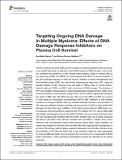Por favor, use este identificador para citar o enlazar a este item:
http://hdl.handle.net/10261/152641COMPARTIR / EXPORTAR:
 SHARE SHARE
 CORE
BASE CORE
BASE
|
|
| Visualizar otros formatos: MARC | Dublin Core | RDF | ORE | MODS | METS | DIDL | DATACITE | |

| Título: | Targeting ongoing DNA damage in multiple myeloma: effects of DNA damage response inhibitors on plasma cell survival |
Autor: | Herrero, Ana B. CSIC ORCID; Gutiérrez, Norma Carmen | Fecha de publicación: | 19-may-2017 | Editor: | Frontiers Media | Citación: | Frontiers in Oncology 7: 98 (2017) | Resumen: | Human myeloma cell lines (HMCLs) and a subset of myeloma patients with poor prognosis exhibit high levels of replication stress (RS), leading to DNA damage. In this study, we confirmed the presence of DNA double-strand breaks (DSBs) in several HMCLs by measuring γH2AX and RAD51 foci and analyzed the effect of various inhibitors of the DNA damage response on MM cell survival. Inhibition of ataxia telangiectasia and Rad3-related protein (ATR), the main kinase mediating the response to RS, using the specific inhibitor VE-821 induced more cell death in HMCLs than in control lymphoblastoid cells and U266, an HMCL with a low level of DNA damage. The absence of ATR was partially compensated by ataxia telangiectasia-mutated protein (ATM), since chemical inhibition of both kinases using VE-821 and KU-55933 significantly increased the death of MM cells with DNA damage. We found that ATM and ATR are involved in DSB repair by homologous recombination (HR) in MM. Inhibition of both kinases resulted in a stronger inhibition that may underlie cell death induction, since abolition of HR using two different inhibitors severely reduced survival of HMCLs that exhibit DNA damage. On the other hand, inhibition of the other route involved in DSB repair, non-homologous end joining (NHEJ), using the DNA-PK inhibitor NU7441, did not affect MM cell viability. Interestingly, we found that NHEJ inhibition did not increase cell death when HR was simultaneously inhibited with the RAD51 inhibitor B02, but it clearly increased the level of cell death when HR was inhibited with the MRE11 inhibitor mirin, which interferes with recombination before DNA resection takes place. Taken together, our results demonstrate for the first time that MM cells with ongoing DNA damage rely on an intact HR pathway, which thereby suggests therapeutic opportunities. We also show that inhibition of HR after the initial step of end resection might be more appropriate for inducing MM cell death, since it prevents the occurrence of a compensatory NHEJ repair mechanism. These preclinical observations provide the rationale for its clinical evaluation. | Versión del editor: | http://dx.doi.org/10.3389/fonc.2017.00098 | URI: | http://hdl.handle.net/10261/152641 | DOI: | 10.3389/fonc.2017.00098 | ISSN: | 2234-943X |
| Aparece en las colecciones: | (IBMCC) Artículos |
Ficheros en este ítem:
| Fichero | Descripción | Tamaño | Formato | |
|---|---|---|---|---|
| Targeting Ongoing DNA Damage in Multiple Myeloma.pdf | 5,9 MB | Adobe PDF |  Visualizar/Abrir |
CORE Recommender
PubMed Central
Citations
26
checked on 10-abr-2024
SCOPUSTM
Citations
37
checked on 08-abr-2024
WEB OF SCIENCETM
Citations
35
checked on 25-feb-2024
Page view(s)
318
checked on 16-abr-2024
Download(s)
230
checked on 16-abr-2024

